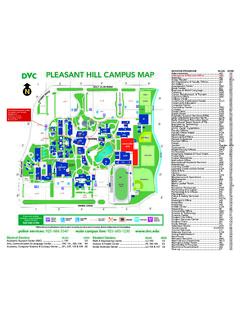Transcription of Ideas for Incorporating SEL Activities into your Classroom
1 Social Emotional Learning (SEL) Guidebook: Ideas for Incorporating SEL Activities into your Classroom Prepared for Diablo Valley College Faculty By Raine Dougan Educating the mind without educating the heart is no education at all Aristotle Introduction Social and Emotional Learning (SEL) is the educational process that helps students develop skills to understand and manage their emotions, resolve conflicts, maintain healthy relationships, make responsible decisions, and effectively deal with life challenges. SEL develops emotional intelligence, . which has been demonstrated to have a greater impact on life success than IQ (Goleman).
2 While emotions might seem to be outside the realm of academic learning, a focus on SEL in the Classroom provides many pay offs. Research has repeatedly shown that SEL is critical for success and well-being in life. People with social and emotional competence are more likely to: - Have a sense of well-being in their personal lives - Act as contributors to their communities - Have meaningful relationships - Feel happiness in their work lives - Feel more optimistic about their future, and - Demonstrate compassion for others (Casel). The positive impact of SEL on academics has also been well documented. Student performance improves when social and emotional development is fostered by instructors and institutions.
3 A 2010. study by Stanford Professor Gregory Walton and University of Texas at Austin Professor David Yeager found that a relatively little amount of social and emotional learning can produce large results. Recent randomized experiments have found that seemingly small social-psychological interventions in education that is, brief exercises that target students' thoughts, feelings, and beliefs in and about school can lead to large gains in student achievement and sharply reduce achievement gaps even months and years later. These interventions do not teach students academic content but instead target students' psychology, such as their beliefs that they have the potential to improve their intelligence or that they belong and are valued in school (267).
4 Recent research continues to support the conclusion that SEL curricula improves academic outcomes. A. Collaboration for Academic, Social and Emotional Learning (CASEL) study of more than 700 programs found that if an institution implements a quality SEL curriculum, they can expect better student behavior and an 11% increase in test scores (Ray). CASEL identifies five key competencies that are seen as instrumental in developing positive relationships and managing life stressors: self-awareness, self- management , social awareness, relationship skills, and responsible decision making. These competencies can broadly be grouped into skills pertaining to understanding and managing the self and skills related to understanding and relating to others.
5 This guidebook seeks to share strategies to incorporate SEL into the college Classroom , offering general practices as well as specific instructional interventions. Strategies are divided into two groups aligned with SEL competency areas: 1) self-awareness/ management skills and 2) social awareness/relationship skills. The guidebook closes with resources for those who would like to learn more about SEL. I hope you find the guidebook useful and that you find many ways of Incorporating SEL into your Classroom . General approaches and practices to facilitate social and emotional learning in your Classroom : Create a warm, safe and supportive learning environment.
6 Develop positive relationships with students. Demonstrate care, concern and a belief in their ability to succeed. Allow opportunities for self-reflection and self-evaluation. Create opportunities for cooperative learning, relationship-building and communication. Attempt to establish an interactive dialogue in class rather than a one-way lecture. Incorporate student interests, experiences, and cultural heritage into the curriculum. Work to foster a growth mindset in students (students with a growth mindset believe that intelligence can be developed, as opposed to those with a fixed mindset who believe that people are born with a certain amount of intelligence and ability).
7 Set high academic standards and communicate them clearly to students. Give students choice when possible to increase motivation and instill a sense of ownership over the learning process. Adapt teaching methods to address different learning styles. Consider assessment to be feedback for the instructor as well as the student. Implement ongoing assessment and adapt instruction as necessary in response to students' needs. Develop a balance between lecture and active learning, as well as between individual and collaborative learning. Look for ways to add emotional richness to class content. Students learn and remember best when their emotions are engaged.
8 Continually develop your own emotional intelligence. Practice and model it in your Classroom . Specific exercises and interventions to incorporate SEL into the Classroom : Self-awareness Write the day's agenda on the board. Students feel safer when knowing what to expect. At the beginning of the semester, have each student share a one-minute autobiography . describing themselves and their life experience. Ask students about their previous experience with your subject, and solicit Ideas about how they best learn. Begin class with a couple minutes of mindfulness to calm emotions and focus attention. Engage students in both cognitive and affective inquiry- in addition to asking them what they think about something they are learning, ask how they feel about it.
9 When studying characters (either fictional or historical), ask students to identify how the characters might have felt or be feeling. Conduct quick class check-ins , asking students to reflect on their internal state. Check-ins give instructors a sense of how students are doing and also send the message to students that their emotions matter. Examples of check-ins: raise your hand low to high to show your level of confidence or confusion with this material; stand and silently dance the way you are feeling at this moment; name an animal that represents your mood; use a nature metaphor (river, meadow, etc.)
10 To capture your current mood; report your stress level on a scale of 1 10;. describe how you are feeling in one word; name a song lyric that expresses your current mood. Pay attention and notice differences in the demeanor and behavior of your students. In individual interactions, reflect back to them what you are seeing and inquire about their attitudes and emotions. Ask students to relate the material discussed in class to their life and personal interests. Have students discuss this in small or large groups, or assign writing on the topic. Students will be more engaged and attentive if they identify personal meaning in the curriculum and studies suggest their grades will improve significantly.










